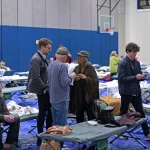
In 2015, while working at a London hair salon, Joshua Coombes took to the streets with his scissors to build relationships with people sleeping rough in the capital, and began posting transformative images on social media to amplify their voices.
These stories resonated and thousands of people got involved in their own way. From this, #DoSomethingForNothing was born – a movement that encourages people to contribute their skills and time to those who need it.
I arrived in Melbourne from London with Jamie Morrison, to put on an art exhibition with HoMie, a Melbourne-based street-wear company and social enterprise that supports young people affected by homelessness and other hardships.
We’d partnered with HoMie to create an Australian instalment of Light & Noise featuring portrait paintings of men and women experiencing homelessness. We had three weeks until the night of the show and intended to spend the first of those out on the streets, getting to know people who would become part of the exhibition. It was the beginning of December 2019. We flew in on Sunday and went out for a walk around the city the next day.
Bourke Street runs through the heart of Melbourne’s CBD – the central business district. It was a clear morning and the streets were already bustling with shoppers. We reached a set of steps near the entrance of a large mall and noticed a girl sitting hunched over a plastic cup at her feet. This was Christine. Jamie and I approached to say hello and told her it was our first day in town. I asked how long she’d been sitting there.
“I’ve been here a little while,” Christine said. “I’m just trying to get enough money to sleep somewhere tonight. It’s pretty busy, but you’d be surprised how little people actually stop, or reach into their pockets …”
Christine was timid. Her arms were crossed, and her shoulders hunched. The hoodie she was wearing hung loosely on her tiny frame.
I asked Christine if it was alright for us to sit with her for a bit longer. Jamie offered to get her something to drink and went to find the nearest café. I took the opportunity to speak about why we’d come to Melbourne and the upcoming exhibition. I showed her some of Jamie’s paintings on my phone.
“Wow, that’s amazing . . . So, are all of these people homeless?” she asked. As the minutes passed, Christine seemed more comfortable and our conversation flowed. “Are you an artist too?”
“I cut hair. I guess that’s my art in some way.”
“Oh. Cool! So, where do you do that?”
“Actually, right here on the street. I’ve got all my things with me in my backpack.” I unzipped one side of it, exposing the tools within. “You know what I’m going to ask you now, right, Christine? Would you like me to give you a haircut?”
She giggled bashfully. “Um … I don’t know. That would be good. It’s been a while … I think I need a little bit of length off the bottom.”
Jamie returned with some coffee. After such a long journey, it was nice to get out and meet someone like Christine. There’s something grounding about a simple conversation with a stranger. It can remind you of what’s important. Christine’s hair was slept on. I sprayed some water and her curls came back to life. The streets got busier as lunch hour arrived. I looked around and began to recognise this area. My eyes followed the steps that we were sitting on to the end of the street. I realised that I’d spent some time here on my last trip to Melbourne.

Four years prior, I’d cut hair for a man named Luke. His charisma and kind nature had left an impression on me. Luke had been homeless for almost six months when we met. He’d wake up early each morning and spend hours making these intricate little bracelets out of materials he’d found, giving them to passersby. As I cut Luke’s hair, a security guard lingered outside a nearby shop, and went out of his way to call me aside afterward. “Why are you helping this person?” he asked. “He should be working like I am working right now.”
See, the thing is, Luke had been working. He even pointed out the high-rise building where he’d clocked in to his nine-to-five until just a few months before. He’d worked in logistics for an agency until earlier that year. His boss didn’t like him much. They had an argument one day and Luke was fired. After working a casual job in a warehouse for a short time, he couldn’t keep up with his rent and spent his first night sleeping out in Melbourne’s CBD. However, Luke was anything but downtrodden when we met. He smiled and radiated positive energy, sharing how he’d like to move forward after this period of his life.

“I think I might move into something really positive when I start working … social work, or something like that. It’s something I’ve never really done, but I’d like it. Some of the most amazing things that have happened in my life have happened here … on the street. Like, just a couple of weeks ago, this mother and her daughter walked by and dropped a dollar, so I gave them a bracelet. They walked off, then maybe five minutes later they came back and said, ‘Thank you so much for this bracelet.’ They gave me hugs and it just made my day.”
Aside from an aging father that Luke had an arduous relationship with, and a few cousins in New Zealand, he had little in the way of a support network. Through his struggles, Luke showed resilience and made the best of his situation. I’d find out how things played out for him in the days leading up to our art exhibition.
As I finished cutting Christine’s hair, she spoke of a friend who was also homeless and sitting nearby. “I’m really tight with my friend Jody, she’s just up the street … We stay together some nights.”
I put my hands into her curls and scrunched deep at the root to give some volume.
“We could walk up and find her now, if you’d like,” I said.
“Oh yeah, sounds good,” she replied. “I can go there with you guys.”
The three of us walked up Bourke Street until we reached a jewellery store, where we found Jody sitting outside with her dog, Shadow.
“Hey, Jody!” Christine called out as we got closer.
There were layers of blankets between Jody and the concrete. Her peroxide-blonde hair hid most of her face at first, until she brushed some of it behind her ear and looked up at us.

Christine showed Jody her new haircut and introduced us.
“Very nice!” Jody said. “Where did you have it cut?”
“Right on the street. Josh is a hairdresser and Jamie is an artist. They wanted to come and meet you.”
Jamie asked Jody if she would like to be in one of his paintings for the exhibition, which prompted a look of surprise.
“A painting of me?” Jody laughed. “Really? Umm . . . Okay, why not, I guess.”
While I spoke with Christine, Jamie got to know Jody a little better and took her picture. That’s part of his process – a black-and-white image, used later as a reference for a painting. I’m always amazed at how prolific Jamie is once he gets started. During our first exhibition in Los Angeles, his “studio” was our friend Isaac’s backyard. In Melbourne, it was the balcony of Marcus’s shared house –Marcus being one of HoMie’s co-founders and a close friend. It was a pretty humble space. Jamie would sit there painting for two weeks straight, finishing ten portraits of people we had met.
Christine decided to head back to her spot. It was my opportunity to ask Jody if she’d like a haircut too.
“Sure!” she responded. “I’ve got so much though.” Jody messed with her hair. “I doubt you’ll be able to get through it.”
Jody was right: she had absolutely tons of hair. But that gave us more time to get to know one another.
“There are some hostels we can stay in, for sure, but I won’t use them because, one, they won’t let the dogs in at night, and two, there are too many idiots there … meth heads who carry on all night, flying around, so you don’t get much sleep. Sometimes you’re sleeping on the floor anyway, so what’s the point of me being in there? I might as well be out here. I think people assume we’re all junkies and that we just want money to go and get off. They don’t realise that some of us are legit and are what we say we are.”
Every so often, the passing trams, constantly circulating, would ring their bells, the chimes merging with the indistinct chatter of the people around us.
Jody continued: “I find it hard to trust people … Some people will take anything. Two years ago, I bought a dog’s bed for nearly one hundred dollars. I saved up some money, it was a really good one. I had to go to the toilet, not even five minutes, and I came back and it was gone. There were other things that they could have stolen, but they chose that. It was close to Christmas Day as well.”
Jody was playful but tough at the same time. I can’t imagine the difficulties of surviving on the streets as a woman. I grew up in a family of women. Thinking of one of them sleeping on the streets freaks me out. A plethora of vulnerabilities comes without a safe space to shut out the world and digest what life is throwing at you. There’s no doubt that being female brings additional challenges.
When we were finished, Jody shook her hair from side to side and swept her hands through it with new confidence.
In the week that followed, Jamie and I walked around Melbourne making friends with more people sleeping rough in the city. Jamie’s paintings came to life, as did HoMie’s new warehouse space, which was the location of the event. We collaborated with local artists to help amplify the voices of those we’d met and put on an evening to remember.
A friend found and lost
The week before the show, I posted a photo of Luke on Instagram, talking about the time he and I had spent on the steps near Bourke Street years before. I received a message later that evening. As my eyes scrolled through the stranger’s words, I sensed what was coming.
Luke had passed away over two years ago.
I know mine and Luke’s paths might never have crossed again, but I still think about that day we shared, preserved in time. Jamie decided to paint a portrait of Luke for the exhibition. We hung it high up on the wall of the gallery space, looking out across the room. Hundreds of people came that night, buying prints, T-shirts and paintings to raise money for HoMie, or the people featured within them. Jody and Christine couldn’t make it, but I went back to see them once more before leaving town and printed out some photos to give to them. I walked up and down the street a few times, but couldn’t find them at first. I glanced at Jody’s spot one more time before leaving, and there she was, sitting herself down with Shadow at her side. It was good to see her again; I showed her Jamie’s art and asked how she liked her haircut.
“Aww. You know, the amount of people who have given me compliments so far … People haven’t been able to recognise me. It’s sweet!”
This is an edited extract from Do Something for Nothing by Joshua Coombes; photography by Irene Conesa González: p. 167, 169; all other photography by Joshua Coombes. Murdoch Books, RRP $35
The post <i>Do Something for Nothing</i>: How the simple act of a haircut inspired a movement appeared first on The New Daily.
Powered by WPeMatico






